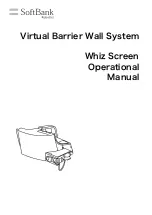
Collaborative Robot Safety
PreciseFlex™ DDR Collaborative Robots
P/N: PFD0-DI-00010, Rev 5.0.0, April 9, 2022
28
Copyright © 2022, Brooks Automation, Inc.
8.
Position error, force limits and collision detection
. The PFDD robots have a control function
that limits the maximum force of any axis. This function is used to limit the crushing force of
various axes. If the force limit is exceeded due to a collision, a position tracking error will be
generated and will generate either a Category 2 or Category 1 Estop, depending on the
magnitude of the error. The controller continuously monitors the commanded robot trajectory
versus the actual position at a rate of 2000Hz. If the position error exceeds a threshold, typically
set to a few tenths of a degree, the controller stops the robot motion. This function works at all
times if the controller CPU is operating
.
This can be demonstrated by pushing on the robot while
stationary to generate a position envelope error. There are redundant monitor functions that
check that the position error and force limits are operating correctly. In addition to the position
error monitor, there is a PID command limit error. If the PID command is saturated at its limit for
200ms, the motor power will be turned off.
This is a CAT 3 compliant function.
TUV has verified
this fail-safe operation.
9.
Motor overheating
. Precise controllers have a “motor duty cycle” monitor which computes the
average power level in a motor and shuts down the motor power if a maximum permissible power
level is exceeded. This can be demonstrated by driving an axis back and forth rapidly enough
that the maximum duty cycle is exceeded and the motor power is turned off.
Test Procedure for the PFDD Robots
The worst-case crash condition for the PFDD robots is when the Z axis is moving downwards at the 100%
speed of 600mm/sec and crashes into the relatively non-compliant hand of an operator pinching the hand
into a hard surface. A test setup to measure this force is shown below in Figure 4.
Figure 4: Vertical Rigid Surface and Horizontal Free Space Test Setup
In this test setup a digital force gage (traceable to NIST standards) is mounted below (or to the left for
horizontal testing) of the gripper of the robot and a “hand compliance simulator” consisting of two plates
separated by compression springs with a compression constant of 75N/mm equal to the compression
constant of a human hand (from figure 2) is attached to the force gage. For the Z test the robot is driven
downwards in the Z direction at various speeds and crashes into the hand simulator attached to the force
gage. For the Horizontal tests the robot is driven horizontally at various speeds into the hand
















































